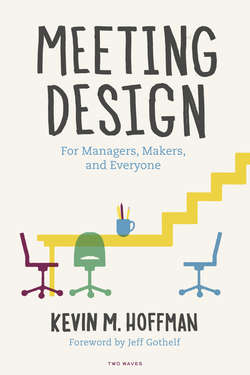Читать книгу Meeting Design - Kevin M. Hoffman - Страница 27
На сайте Литреса книга снята с продажи.
Putting the Brain to Work for Jane’s Meeting
ОглавлениеEverything you perceive to be real in the world happens as input into your brain. By considering the brain as the primary design constraint for a meeting, you engineer powerful learning experiences, focus teams on the right aspects of projects, and accommodate different modes of input within a meeting.
Remember Jane and her three teams at the Caribbean airline? By taking advantage of visual capture via Post-it Notes, she could break the ideas for each of the two lists (time savings and cost savings) into a wall-sized representation of the lists themselves. These lists could be created, at least in part, during the meeting. Distributing a photo of the results of the meeting wall immediately afterward would provide enough context for any additional work to be at the appropriate level of detail. Additional meetings could be eliminated, and Jane’s team would have more clarity, because their memories would be more accurate.
WHAT YOU NEED TO KNOW
People, and specifically their brains, are a universal design constraint for meetings. The best way to design for this constraint is by creating ways to support more effective creation of memories. Here are several ways to make that happen:
• Working memory is the most active stage of memory in a meeting. It lasts on average 30 seconds, but it varies between individuals. You should cover information at a pace that is slower than you would normally use in a one-on-one conversation and break it into even chunks.
• Working memory has distinct ways in which it handles sights and sounds. Engage both by combining visuals with discussions in a complementary, not competing, style.
• The stage of memory that has the most capacity to create work after the meeting is intermediate memory. A meeting’s length can interfere with keeping good intermediate memories if it is too long.
• The brain receives information in meetings via sound, sight, and touch inputs.
• People will listen better (and form stronger memories) by breaking content into 20- to 30-minute presentations, activities, or interactions. Each interaction should also include time for discussion of what was learned. This helps move working memories into intermediate ones.
• Eating healthy fats and proteins will do a better job of sustaining people’s attention in longer meetings than donuts and cookies.
• Creating and reinforcing memories with visuals are great ways to activate part of the brain that isn’t otherwise possible. Visual facilitation is the practice of exclusively using sketching to facilitate discussions, and it is an example of why simple visuals are uniquely effective.
• Objects you can physically manipulate, such as sticky notes and small physical prototypes, further empower the relationship between visualization and listening in the brain. These are called manipulatives.
